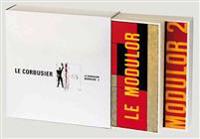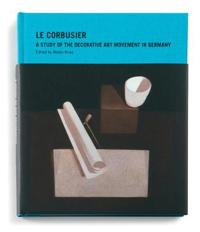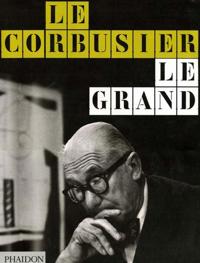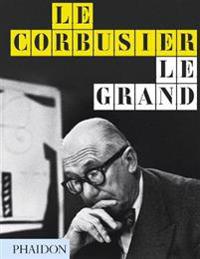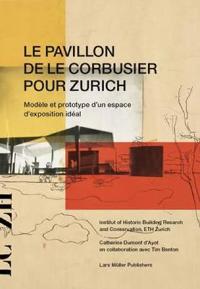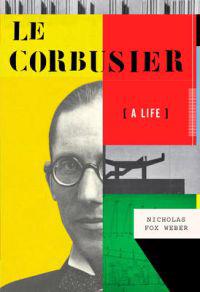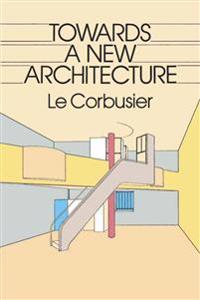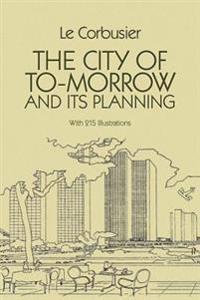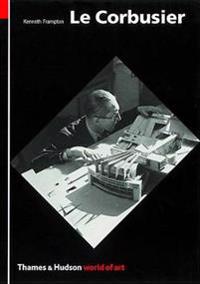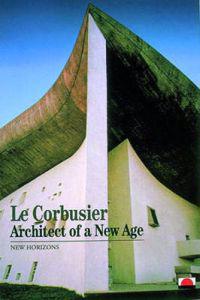Le Corbusier Talks with Students (Häftad)
avLe Corbusier
ISBN: 9781568981963 - UTGIVEN: 199910First published in France in 1943 and translated for English-speaking readers in 1961, this work presents advice and commentary from the master of modernism for young architects-to-be. In chapters ranging from "Disorder" to "The Construction of Dwellings" to "A Research Workshop", Le Corbusier discu[...]
Le Modulor, Modulor 2 (Pocket)
avLe Corbusier
ISBN: 9783764361877 - UTGIVEN: 2000-05In the years 1942 to 1948, Le Corbusier developed a system of measurements which became known as "Modulor." Based on the Golden Section and Fibonacci numbers and also using the physical dimensions of the average human, Modulor is a sequence of measurements which Le Corbusier used to achieve harmony [...]
Le Corbusier: A Study of the Decorative Art Movement in Germany (Inbunden)
avLe, Mateo Kries, Alexander Von Vegesack
ISBN: 9783931936297 - UTGIVEN: 201309First published in 1912, "Etude sur le mouvement d'art decoratif en Allemagne" was Le Corbusier's first publication. In it, the young architect lucidly analyzed the German applied arts movement and its protagonists (such as Peter Behrens, for whom Le Corbusier worked in 1910-11). The text is one of [...]
Le Corbusier Le Grand (Inbunden)
avPhaidon Press, Editors of Phaidon, Phaidon Press
ISBN: 9780714846682 - UTGIVEN: 200805Le Corbusier (1887-1965) is one of the giants of twentieth-century architecture and design. Born Charles Edouard Jeanneret in La Chaux-de-Fonds, Switzerland, the self-named Le Corbusier was not only the creator of some of the most important and impressive buildings of the last century - Villa Savoye[...]
Le Corbusier Le Grand (Inbunden)
avJean-Louis Cohen
ISBN: 9780714868691 - UTGIVEN: 2014-11A spectacular visual biography of one of the greatest architects of the 20th century.
Le Corbusier Le Grand (häftad)
ISBN: 9780714879109 - UTGIVEN: 2019-01A spectacular visual biography of the life and work of Le Corbusier - one of the twentieth century's most influential architects A decade after its first publication, the bestselling monograph Le Corbusier Le Grand is finally available in a new paperback edition. Documenting the life and work of one[...]
Le Pavillon De Le Corbusier Pour Zurich (Pocket)
avCatherine Dumont D'ayot, Tim Benton, Catherine Dumont D'ayot
ISBN: 9783037783283 - UTGIVEN: 2013-01Le Corbusier's Pavilion for Zurich uses numerous handwritten documents, drawings, and papers to trace the history of Le Corbusier's last built work. This dwelling, which is also a museum, was initiated by Zurich gallery owner Heidi Weber. With its abstract forms and colors, it represents an intellec[...]
Le Corbusier and the Occult (Inbunden)
avJ.K. Birksted
ISBN: 9780262026482 - UTGIVEN: 200902When Charles-Edouard Jeanneret reinvented himself as Le Corbusier in Paris, he also carefully reinvented the first thirty years of his life by highlighting some events and hiding others. As he explained in a letter: "Le Corbusier is a pseudonym. Le Corbusier creates architecture recklessly. He pursu[...]
Le Corbusier Sketchbooks: v. 4: 1957-1964 (Inbunden)
avFrancoise De Franclieu, Architectural History Foundation
ISBN: 9780262120937 - UTGIVEN: 1982-01-01Le Corbusier in America (Häftad)
avMardges Bacon
ISBN: 9780262523424 - UTGIVEN: 200304Le Corbusier's first trip to the United States in 1935 is generally considered a failure because it produced no commissions. The experience nevertheless had a profound effect on him, both personally and professionally. Sponsored by the Museum of Modern Art in New York, Le Corbusier promoted his idea[...]
Journey to the East (Övrig)
avLe Corbusier
ISBN: 9780262622103 - UTGIVEN: 2007-11-06This is the legendary travel diary that the twenty-four-year-old Charles-Edouard Jeanneret (Le Corbusier) kept during his formative journey through Southern, Central, and Eastern Europe in 1911. In a flood of highly personal impressions and visual notations, it records his first contact with the ver[...]
Le Corbusier
ISBN: 9780300230994 - UTGIVEN: 2018-11"Each day of my life has been dedicated in part to drawing. I have never stopped drawing and painting, seeking, where I could find them, the secrets of form."-Le Corbusier Charles-Edouard Jeanneret, known as Le Corbusier (1887-1965), is famous for transforming 20th-century architecture and urbanism.[...]
Voyage Le Corbusier
ISBN: 9780393733563 - UTGIVEN: 2016-02Here, Jacob Brillhart excavates the "visual thinking" of the twentieth century's pioneer architect, reproducing a selection of 175 drawings from the early sketchbooks of Charles-Edouard Jeanneret, whom we now know as Le Corbusier. Between 1907 and 1911, Jeanneret studied in Switzerland and travelled[...]
Brunelleschi, Lacan, Le Corbusier (Pocket)
avLorens Holm
ISBN: 9780415419697 - UTGIVEN: 2009-12-01Thoroughly illustrated, this text argues that perspective remains the primary and most satisfying way of representing form, because it is the paradigmatic form of spatial consciousness.[...]
Le Corbusier and Britain: An Anthology (Inbunden)
avMurray Irena
ISBN: 9780415479943 - UTGIVEN: 2008-09-26Le Corbusier (1887-1965) is arguably the most influential architect of the twentieth century. Despite the fact that he designed no permanent buildings in the United Kingdom, more than any other individual he was responsible for shaping British post-war architecture. Le Corbusier and Britain traces t[...]
Le Corbusier (Inbunden)
avRoberto Gargiani, Anna Rosellini
ISBN: 9780415681711 - UTGIVEN: 2011-09-28This groundbreaking new perspective on Le Corbusier is based on exhaustive archival research and the study of neglected or completely unknown documents. It is innovative in showing the role of materials and construction techniques in the architecture of Le Corbusier and the book also delves into the[...]
Le Corbusier (Pocket)
avGeoffrey H. Baker
ISBN: 9780419161202 - UTGIVEN: 1996-10-17This unique appraisal of the famous Swiss architect's major works have now been expanded to include two more building. The Villa Shodhan and the Pavilion Suisse round out the coverage of Le Corbusier's significant works. The author critically[...]
Le Corbusier: Architect and Feminist (Häftad)
avFlora Samuel
ISBN: 9780470847473 - UTGIVEN: 2004-02-29Towards a New Architecture (Häftad)
avLe Corbusier
ISBN: 9780486250236 - UTGIVEN: 198502This pioneering proclamation by the great architect expounds Le Corbusier's technical and aesthetic theories, views on industry, economics, the relation of form to function, "mass-production spirit," and much more. Profusely illustrated with over 200 line drawings and photographs of Le Corbusier's b[...]
The City of Tomorrow and Its Planning (Häftad)
avLe Corbusier
ISBN: 9780486253329 - UTGIVEN: 200002The great revolutionary architect's probing analysis of urban problems and their origins, and his bold solutions, which include the "Voisin" scheme for the center of Paris, and the more developed scheme for a "City of Three Million Inhabitants." Introduction. Foreword. 133 black-and-white illustrati[...]
The Modern Chair: Classic Designs by Thonet, Breuer, Le Corbusier, Eames and Others (häftad)
ISBN: 9780486839295 - UTGIVEN: 2019-08Le Corbusier (Häftad)
avKenneth Frampton
ISBN: 9780500203415 - UTGIVEN: 200105Le Corbusier's ideas and works constitute the greatest single influence in the development of architecture in the 20th century. His passionately expressed philosophy has had an enormous effect on the urban fabric and the way we live. Weaving through his long and prolific life are certain recurrent t[...]
Le Corbusier (Häftad)
avJean Jenger, Caroline Beamish
ISBN: 9780500300671 - UTGIVEN: 199610One of the most influential architects of the 20th century, Le Corbusier, has shaped the world in which we live - from his experiments in communal living to his extraordinary churches, such as the Ronchamp chapel, and luxury houses for rich patrons. This book celebrates his vision of architecture as[...]


